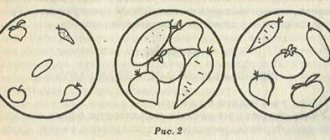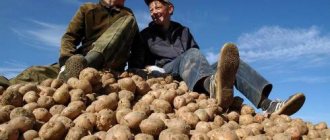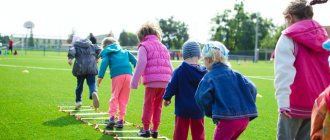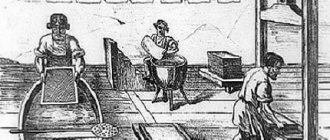Lexical and grammar lesson on the topic: “Vegetables”
Integration of educational areas:
- "Cognitive Development"
- “Socio-communicative development”,
- "Physical development"
Software tasks:
Speech development:
1. Consolidate and activate the vocabulary on the lexical topic “Vegetables”.
2. Exercise in the formation and use in speech of nouns with diminutive and augmentative meanings
3. Continue to teach how to answer the questions posed.
Cognitive development:
1. Develop observation, attention, thinking, coherent speech.
Social and communicative development:
1. Continue working to foster friendly relationships between children.
Physical development:
1. Develop fine motor skills of the fingers.
2. Develop the ability to coordinate speech with movements.
Equipment: subject pictures depicting vegetables, plot picture “Vegetable Garden”, vegetables (tomato, cucumber, cabbage, carrots, potatoes, onions, garlic, zucchini, eggplant, peppers, radishes, turnips, radishes, pumpkin).
Summary of the integrated lesson “Preparing vegetables for the winter” for children 4-5 years old
Summary of the integrated lesson “Preparing vegetables for the winter” for children 4-5 years old
Author: Olga Nikolaevna Zolotareva Author’s position: Additional education teacher
Name of the institution where the author works: GBUDOD OODTDM im. V.P.Polyanichko, DOC "Poyanka" Orenburg
Topic: “Preparing vegetables for the winter”
Goal: To introduce children to the fruits of vegetable crops. Age: 4-5 years Program objectives: • Teach children to describe vegetables according to their characteristic features; • Learn to recognize vegetables using visual and taste analyzers; • Learn to draw potatoes with gouache (finger technique), develop rhythm when applying stains with your fingers.
Equipment and materials: pictures of vegetables, vegetables - dummies; flannelgraph, vegetables and fruits cards for the flonegraph, a recording of the song “Gather the Harvest” (Songs by T. Volgina, Music by A. Fillipenko) and the disc by Ekaterina and Sergei Zheleznov “Songs for Massage. Bike"
For drawing: brown gouache, a “bag” cut out of paper, a napkin, a glass of water. Progress of the lesson. 1. Organizational moment. Teacher: Guys, come to the window and look how beautiful it is. Multi-colored leaves on the trees. A carpet of leaves was spread on the ground. How beautiful it is all around. What time of year brought us such beauty? (Autumn) - And you know, guys, Autumn gives people a lot of gifts. Recently, autumn has given us a whole basket of beautiful fruit leaves. – Today Autumn brought us gifts again. Let's find where autumn hid them. To do this we need to go to the garden. 2. Main part. Musical exercise “We’re going to the garden” (the music of Ekaterina and Sergei Zheleznov “Bicycle” sounds, children sitting on rugs imitate the movement of a bicycle) Didactic game for speech development “Describe the vegetables”. Teacher: Here we are in the garden. Vegetables grow in the garden. Now we will find them. (The teacher hands out pictures of vegetables to the children and asks them to find in the garden the vegetable that is shown in the picture, and then answer the teacher’s questions: name - size - color - shape) - What is this? (potato) - What is it like? (small, brown, round) Teacher: Eroshka the Hedgehog took the spatula - Potatoes are waiting for him in the field. Today is a generous harvest, Don’t yawn and harvest! (F. Lilac) - What is this? (cabbage: large - white - round) Teacher: She was a sprout, she drank all the water. She turned white, got fat, crunched like sugar. I lived through the summer, saved a lot of leaves, got dressed, got dressed, but couldn’t undress. (A. Prokofiev) - What is this? (carrot: small - orange - long) - What is this? (beets: large and small - crimson, round) Teacher: If only there was a hunt - We can distinguish them in no time. Carrots have a red color, beets don’t have this color - - What is this? (onion: large and small - golden - round) Teacher: The feathers of the onion turn green and grow longer from the sun, He is impatiently waiting for the rain to come from the watering can. (Other vegetables are described in a similar way) Exercise “Where fruits grow” The teacher tells the children that fruits grew on a tree - in the garden, and cabbage, carrots, beets, onions are vegetables and they grow on the ground in the garden. (The teacher draws the children’s attention to the beds attached to the flannelgraph; the children plant vegetables in their place on the flannelgraph). — What’s growing in the cucumber bed? (cucumbers) - What grows in the carrot bed? (carrots), etc. Finger gymnastics. Teacher: All summer they look after the vegetables: water them, loosen the soil, fertilize them. And then in the fall they harvest. We will now collect the cabbage and prepare it for the winter. (they imitate the corresponding movements with their hands) - We are chopping cabbage! (straight, tense palms imitate the movements of an ax: up - down) - We are cutting cabbage! (movements with straight palms forward and backward) - We salted the cabbage! (fingers gathered in a pinch, “salt the cabbage”) - We press the cabbage! (we clench our fingers into fists) - We are three carrots! (the fingers of one hand are clenched into a fist and make rhythmic movements up and down the palm of the other hand. Then we change hands). Exercise “Test what kind of vegetable it is.” The teacher offers to treat themselves to vegetables. Children try and tell what kind of vegetable they tried. Finger drawing “Collecting potatoes in a bag.” Teacher: There is a big potato harvest this year. Frost is coming soon, but we haven’t had time to remove the potatoes from the garden. Now we will also collect potatoes. A recording of the song “Gather the Harvest” is playing (lyrics by T. Volgina, music by A. Fillipenko). Children use their fingers to draw potatoes in bags. Reflection Teacher: How hard we worked today, now we will rest a little and listen to music: birds singing, the murmuring of a brook, the rustling of a leaf. (Music “Sounds of Nature” plays) - What sounds did you hear just now? Summary of the lesson. - What gifts has Autumn brought us today? (Vegetables) - What other autumn gifts do you know? (fruits, mushrooms, berries) Teacher: I really enjoyed studying with you. You are real helpers, hard workers.
Tasks
If you want to use pictures on the topic “Vegetables” during speech therapy classes for children, you can offer the following assignment options:
- Pick and describe
The child must sort the images according to “what grows in the garden and in the garden”, and then tell in detail about one or several vegetables.
- List the characteristics of the object
A picture with a vegetable is selected. Then you need to list its characteristics (beets - burgundy, large, round, young, washed).
- Make up a story
Using a plot picture with vegetables, you can come up with a story on the theme “Harvesting” or “Little gardeners.”
Harvesting Little gardeners
- Come up with questions
Based on one subject picture with a vegetable, come up with as many questions as possible:
Where does it grow? What color does it come in? What does it resemble in shape? What dishes can be prepared from it?
- Describe the picture
Invite your child to talk about the vegetable he has on the card: list the external signs, where it grows, and in what form it is eaten.
- Lay it out and tell it
Ask them to sort the images into three groups: what grows underground, in the garden, on a bush.
On the topic: methodological developments, presentations and notes
SUMMARY OF DIRECT EDUCATIONAL ACTIVITIES ON EDUCATIONAL ACTIVITIES SPEECH DEVELOPMENT ON THE TOPIC “MIGRATORY BIRDS” FOR CHILDREN OF THE OLDER GROUP.
Summary of organized educational activities in the educational area “Cognitive Development” on the topic: “Enchanted Mathematical Kingdom” in the senior group.
Goal: to develop the desire to understand the world around us through educational and research activities. Objectives: Educational: to consolidate knowledge about the properties of water (no color, odorless); consolidating.
- to form children’s ideas about plants grown by humans for food; - to consolidate children’s ideas about the needs of plants for light, heat, water; - to develop the ability to understand.
Introducing students to the history of buttons.
Mathematics lesson with preschoolers of the preparatory group on the lexical topic “Wintering birds”.
Source
How to conduct classes
Making each speech therapy session as effective as possible allows not only high-quality visual material, but also its correct use. There are several principles that are important to follow when working with pictures.
- Cards for children should have bright, realistic images drawn on a white background. It is better to use special kits for kindergarten; photography can also be useful.
- The younger the children, the more important it is to show images only of familiar, familiar objects.
- The number of pictures used in one lesson should correspond to the age of the child. For kids, 3-5 are enough; for older kids, you can take up to 10-15 cards.
- During the lesson, use subject and plot pictures on the same topic.
- First, you should introduce the children to the pictures, let them look at them well, and only then take the selected cards for educational games and activities.
"Tops and Roots"
To consolidate knowledge about the way cultivated plants grow, you can play an outdoor game, for which you will need dummies or images of garden and garden fruits.
The teacher shows the picture, the children name the depicted fruit. When asked where it grows, they answer with physical actions:
- on a tree (fruit) - stretch their arms up;
- on the ground (vegetables) - stretch their arms forward;
- underground (root crops) – squat.
Guess by description
A didactic game about fruits and vegetables is built in the form of questions and answers. The teacher names the signs, asks what vegetable he described, and the children must guess and answer. For example:
- red, round, juicy, fleshy (tomato);
- sharp, hot, white inside, with a yellow husk, with thin leaves (onions);
- green, oval, crispy, covered with pimples (cucumber);
- large, round, orange, with a thick crust, with healthy seeds (pumpkin);
- long, triangular, orange, grows in the ground, with curly greenery (carrot).
Didactic game “Vegetables and fruits”
The purpose of the didactic game “Vegetables, Fruits” is to form an idea about garden and vegetable plants, the place and method of their growth, to consolidate in memory the correct names of fruits, to develop the ability to distinguish vegetables from fruits by external signs.
The middle group of kindergarteners plays an educational game.
For the lesson, you need to prepare models of trees and garden beds from dense material, and cut out recognizable images of fruits and vegetables.
The teacher lays out pictures of fruits in front of the children, asks them to name them, tell where they grow - on trees or garden beds. The students’ task is to correctly determine the place where the crop grows, attach it to a fake tree or place it on a garden bed.
Another version of the game is possible: the teacher places all the pictures on the tree, asks the children whether all the fruits are hanging correctly and which ones need to be moved to the garden.
For the older group of kindergarteners, you can complicate the task by offering:
- separate fruits and root vegetables by color;
- name the geometric shape of vegetables and fruits;
- ask what can be put in a dessert vase and what can be used to make a salad.





